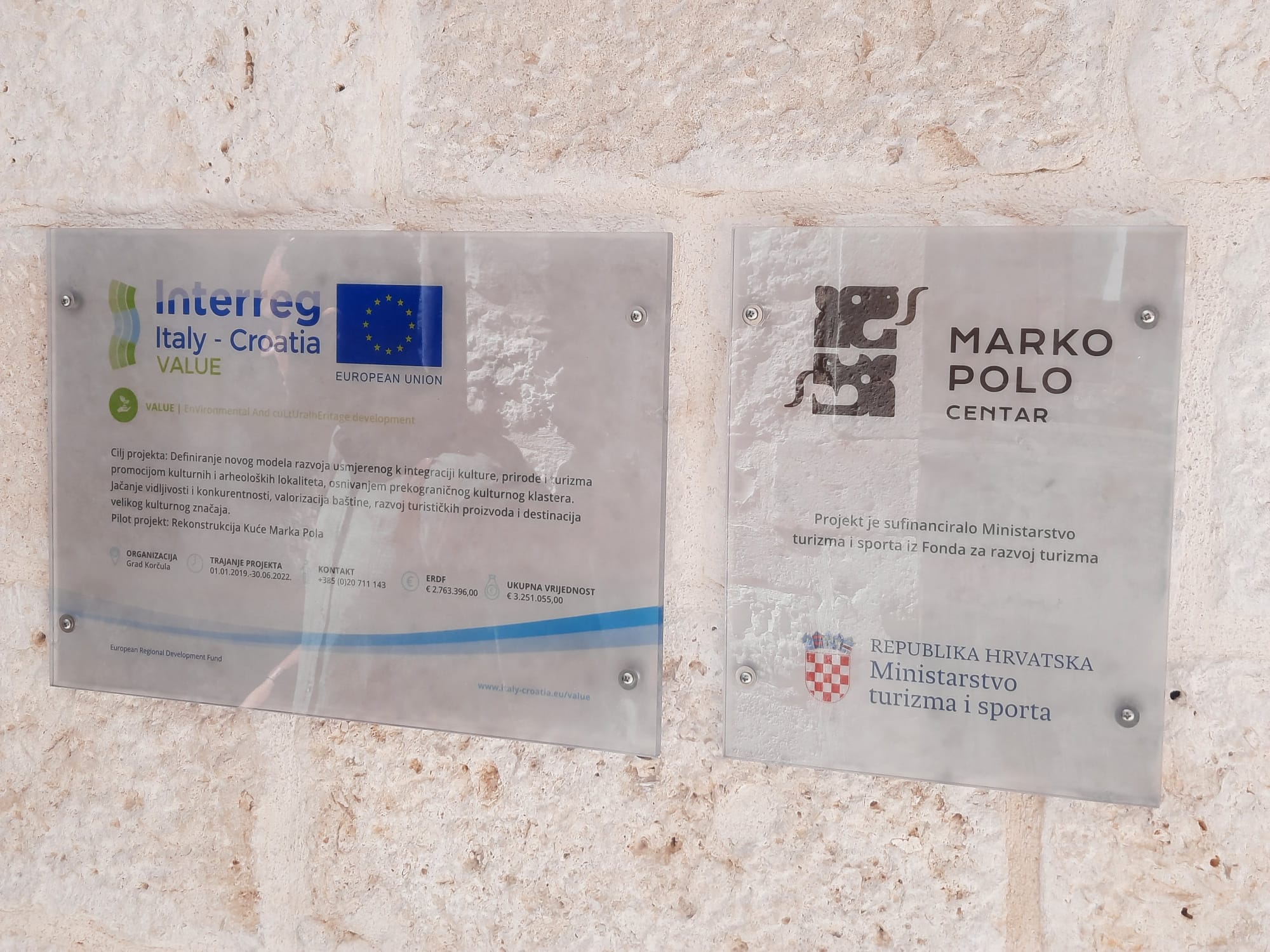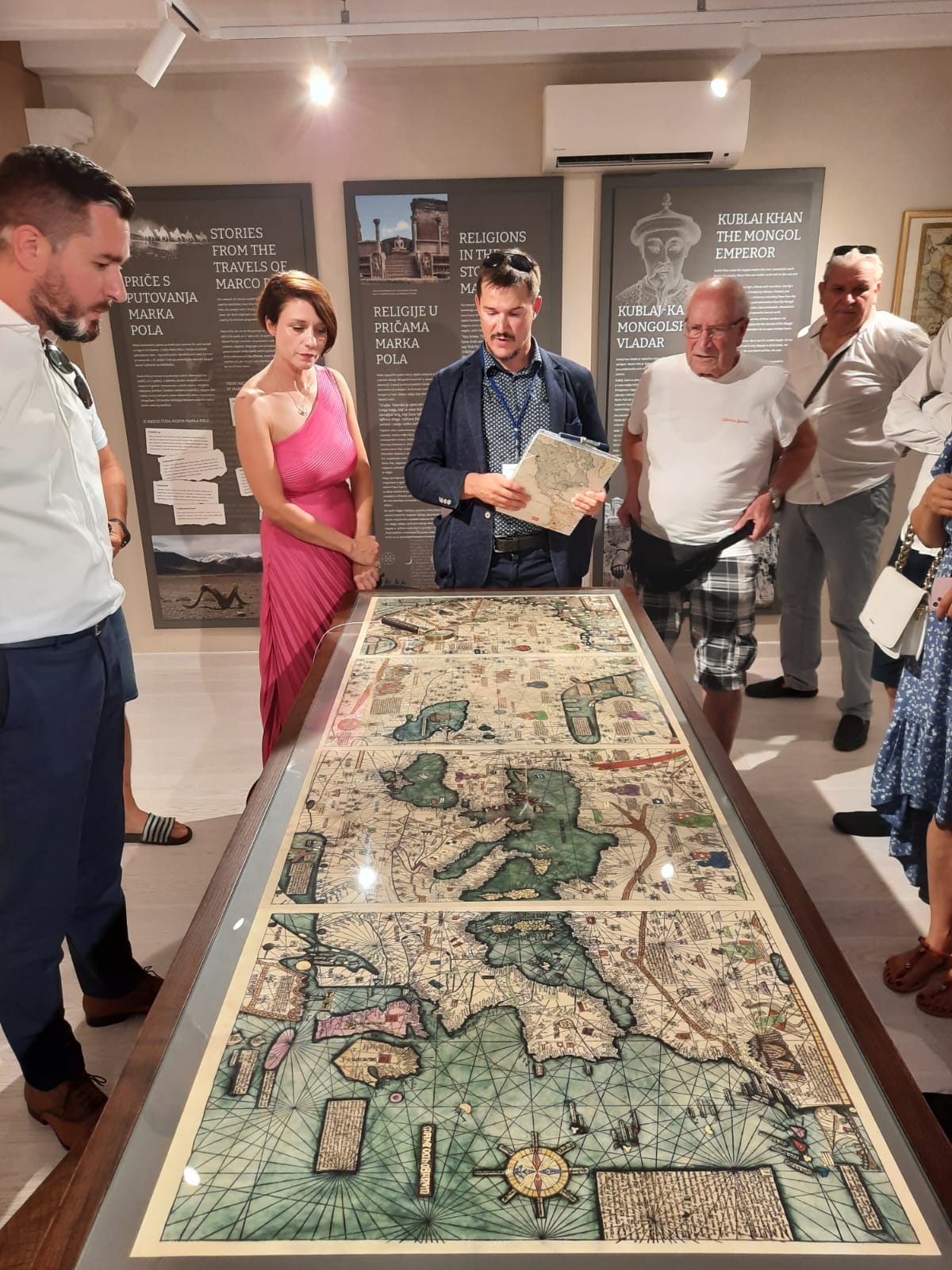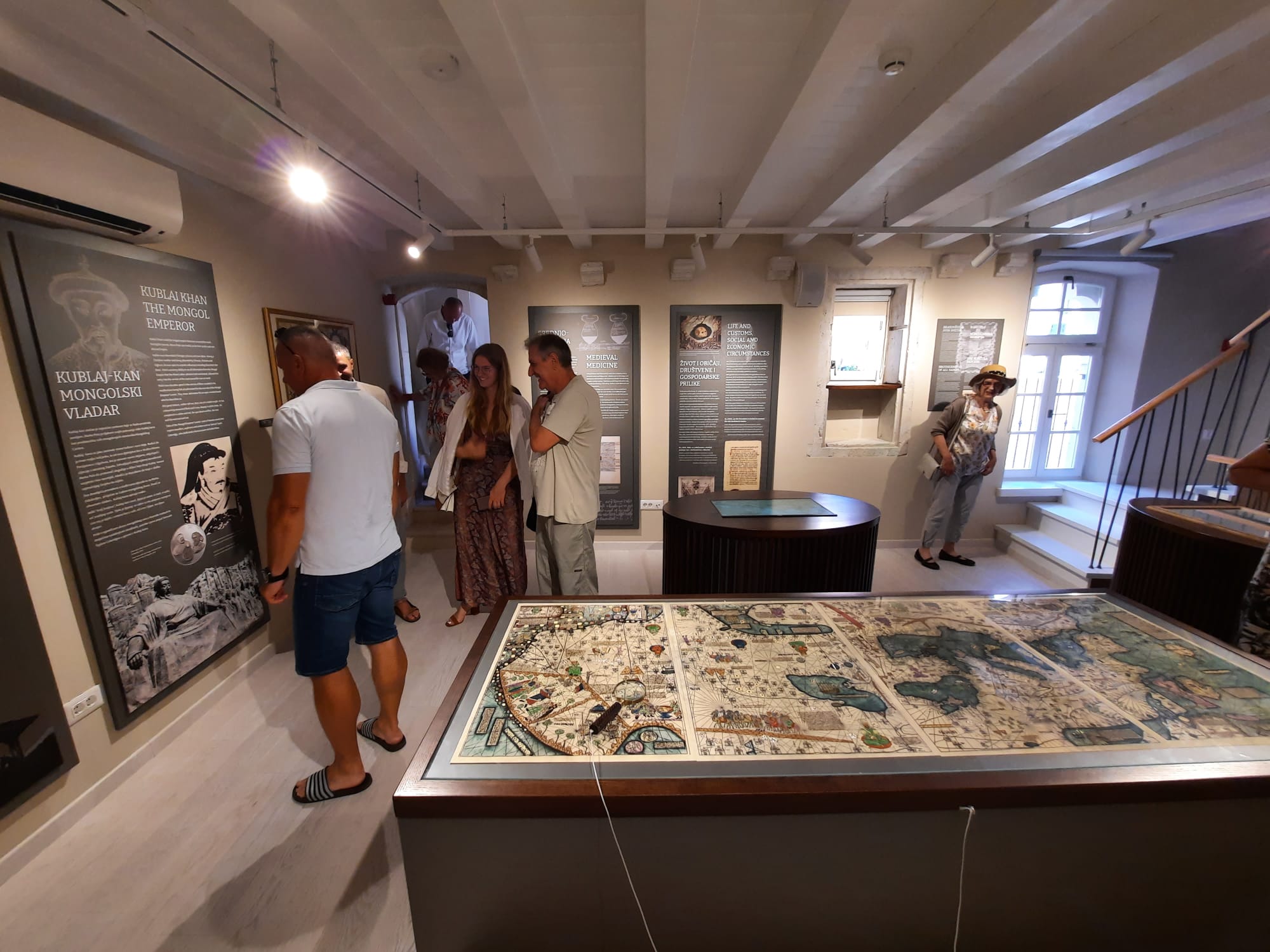Marco Polo, homo adriaticus in spite of everything
Where was Marco Polo born? What is his native country? A question that made little sense in the 13th century – everything was under the control of the Republic of Venice – is nowadays a source of debates, especially between Croatia and Italy. A new project tries to overcome them

Marco-Polo-homo-adriaticus-nonostante-tutto
Korčula – Photo G. Vale
More than ten years have passed since, in 2011, former Croatian president Stjepan Mesić inaugurated a museum dedicated to Marco Polo in Yangzou, China, unleashing an uproar in the Italian press. The question of the birthplace of the author of the Travels has long polluted Italian-Croatian relations, but now it seems that a positive turning point has been reached.
In Korčula, what was known as the "birthplace of Marco Polo" until the early 2000s has been transformed into an "Interpretive Centre" dedicated to the great traveller and financed by the Italy-Croatia Interreg programme. Inside the museum space – inaugurated last Friday – one no longer encounters the age-old Croatian claim according to which Marco Polo was born in Korčula, but a general presentation of the European context of the 13th century and travels to the Far East. The logo of the new centre itself is composed by a lion and a dragon, a reference to the symbols of the Republic of Venice and China.
An age-old question
Mesić’s trip to China (which was followed by many others in a rather unusual pro-Chinese lobbying activity for a former European head of state) fits into the broader context of the diatribe over Marco Polo, or rather over where was he born.
According to some, the question is open, so much so that the Treccani aencyclopedia uses a compromise formula, indicating: "Polo, Marco – Venetian traveller (Venice or Korčula 1254 – Venice 1324)". In fact, there is no document that certifies the explorer’s birthplace and it seems established that his family had ancient Dalmatian origins, more precisely from Šibenik. At the time, these disquisitions made little sense, as all these territories belonged to the same state: the Republic of Venice, which controlled almost the entire eastern coast of the Adriatic.
Today, however, the debate is alive. On the Italian side, scholars such as Alvise Zorzi, author among other things of a biography of the explorer, argue that "there is no doubt that Marco Polo was Venetian, his family had been Venetian since the 10th century". The Croatian side, on the other hand, insists that a certain "DePolo" family owned some houses in Korčula, even if the one that has been referred to for years as the traveller’s birthplace was built at least two centuries after his death. It’s not much, but enough to fuel the local tourist narrative.
From “birthplace” to Interpretive Centre
Until 2003, therefore, Korčula boasted the "birthplace" of Marco Polo. Then the building was closed for renovation and has now reopened under a new guise. The “Marko Polo Centar ” is a multifunctional centre, a museum, and a place of study. Meetings and debates will be organised in the name of culture and encounter, as noted by curator Vicko Marelić, who speaks of "homo adriaticus" in referring to Marco Polo. The project has a total value of around 1.3 million Euros and was financed by the municipality of Korčula, the Dubrovnik county, and various Croatian ministries as well as the VALUE project within the Interreg Italy-Croatia programme, which provided 360,000 Euros.
Organised on several floors, the multimedia space covers almost 300 square metres, guiding the visitor through maps and information panels, interactive screens and period objects. The focus is no longer the claim of Polo’s birthplace, but the context in which his travels in the East took place, from European geopolitics of the 13th century to the figure of Kublai Khan, from the plague to religion in the Middle Ages. On the ground floor there is a small research room, which will collect books on Marco Polo and the many editions of the Travels, while on the top floor, a panoramic point allows you to admire both the centre of Korčula, with the nearby 15th century cathedral, and the sea.
In particular, it is advisable to look towards that stretch of sea where on 7 September 1298 the "battle of Korčula" took place, which pitted the fleet of the Serenissima against the Genoese one and saw the victory of the latter. A large section of the museum is dedicated to the battle – which saw admirals Andrea Dandolo and Lamba Doria challenge each other, at the helm of 96 and 76 ships respectively – on the basis of the fact that Marco Polo himself took part in the battle. According to legend, Polo was captured by the Genoese (another version claims that he was taken prisoner in southern Turkey). Anyway, during his captivity in Genoa the traveller – who returned from the East in 1295 after over twenty years – dictated his book to Rustichello da Pisa.
Tourism first
In the intentions of curator Vicko Marelić, the Centre will welcome "tens of thousands of people a year" – "maybe a million!", he jokes. Like most of the Croatian islands, Korčula thrives on tourism, even if it registers a smaller flow than nearby Hvar and Brač. In 2019, Korčula welcomed almost 175,000 tourists (Hvar 331,000) for a total of 927,000 overnight stays (Hvar 1.6 million). Last year, however, it stopped at 138,000 visitors and 732,000 overnight stays. Most tourists came from Croatia itself, the United States, the United Kingdom, France, and Slovenia.
In this context, the new Centre therefore aims above all to increase the tourist offer of the island and to differentiate it from the others, associating it with an internationally known name. "Korčula, the city of Marco Polo", is already the motto of the city tourist office. “The Marco Polo super-brand can become the biggest tourist attraction in the Mediterranean”, Vicko Marelić argued during the inaugural speech. The wishes of the mayor of Korčula Nika Silić Maroević, who last Thursday cut the ribbon at the entrance to the Marko Polo Centar, go in the same direction: the new centre will bring more tourists.
In the meantime, the dispute is destined to continue, also because there are not only two parties involved – Korčula and Venice – but at least three. In 2013, Croatian anthropologist Olga Orlić published a study titled: “The curious case of Marco Polo of Korčula: an example of invented tradition”, a doctoral thesis that studies just how a legend without historical evidence has become a matter of identity for citizens and local institutions. During an interview for the Extinguished Countries project, a couple of years ago, Orlić said that, shortly after the publication of her work, she received a phone call from an association in Šibenik. “Well done, Dr. Orlić, you’re right!”, they said on the other end of the phone, “we know that Marco Polo was born in Šibenik and we have proof of that!”.
This content is published in the context of the “Work4Future” project co-financed by the European Union (EU). The EU is in no way responsible for the information or views expressed within the framework of the project. The responsibility for the contents lies solely with OBC Transeuropa. Go to the “Work4Future“
Tag: Work for Future
Featured articles
- Take part in the survey
Marco Polo, homo adriaticus in spite of everything
Where was Marco Polo born? What is his native country? A question that made little sense in the 13th century – everything was under the control of the Republic of Venice – is nowadays a source of debates, especially between Croatia and Italy. A new project tries to overcome them

Marco-Polo-homo-adriaticus-nonostante-tutto
Korčula – Photo G. Vale
More than ten years have passed since, in 2011, former Croatian president Stjepan Mesić inaugurated a museum dedicated to Marco Polo in Yangzou, China, unleashing an uproar in the Italian press. The question of the birthplace of the author of the Travels has long polluted Italian-Croatian relations, but now it seems that a positive turning point has been reached.
In Korčula, what was known as the "birthplace of Marco Polo" until the early 2000s has been transformed into an "Interpretive Centre" dedicated to the great traveller and financed by the Italy-Croatia Interreg programme. Inside the museum space – inaugurated last Friday – one no longer encounters the age-old Croatian claim according to which Marco Polo was born in Korčula, but a general presentation of the European context of the 13th century and travels to the Far East. The logo of the new centre itself is composed by a lion and a dragon, a reference to the symbols of the Republic of Venice and China.
An age-old question
Mesić’s trip to China (which was followed by many others in a rather unusual pro-Chinese lobbying activity for a former European head of state) fits into the broader context of the diatribe over Marco Polo, or rather over where was he born.
According to some, the question is open, so much so that the Treccani aencyclopedia uses a compromise formula, indicating: "Polo, Marco – Venetian traveller (Venice or Korčula 1254 – Venice 1324)". In fact, there is no document that certifies the explorer’s birthplace and it seems established that his family had ancient Dalmatian origins, more precisely from Šibenik. At the time, these disquisitions made little sense, as all these territories belonged to the same state: the Republic of Venice, which controlled almost the entire eastern coast of the Adriatic.
Today, however, the debate is alive. On the Italian side, scholars such as Alvise Zorzi, author among other things of a biography of the explorer, argue that "there is no doubt that Marco Polo was Venetian, his family had been Venetian since the 10th century". The Croatian side, on the other hand, insists that a certain "DePolo" family owned some houses in Korčula, even if the one that has been referred to for years as the traveller’s birthplace was built at least two centuries after his death. It’s not much, but enough to fuel the local tourist narrative.
From “birthplace” to Interpretive Centre
Until 2003, therefore, Korčula boasted the "birthplace" of Marco Polo. Then the building was closed for renovation and has now reopened under a new guise. The “Marko Polo Centar ” is a multifunctional centre, a museum, and a place of study. Meetings and debates will be organised in the name of culture and encounter, as noted by curator Vicko Marelić, who speaks of "homo adriaticus" in referring to Marco Polo. The project has a total value of around 1.3 million Euros and was financed by the municipality of Korčula, the Dubrovnik county, and various Croatian ministries as well as the VALUE project within the Interreg Italy-Croatia programme, which provided 360,000 Euros.
Organised on several floors, the multimedia space covers almost 300 square metres, guiding the visitor through maps and information panels, interactive screens and period objects. The focus is no longer the claim of Polo’s birthplace, but the context in which his travels in the East took place, from European geopolitics of the 13th century to the figure of Kublai Khan, from the plague to religion in the Middle Ages. On the ground floor there is a small research room, which will collect books on Marco Polo and the many editions of the Travels, while on the top floor, a panoramic point allows you to admire both the centre of Korčula, with the nearby 15th century cathedral, and the sea.
In particular, it is advisable to look towards that stretch of sea where on 7 September 1298 the "battle of Korčula" took place, which pitted the fleet of the Serenissima against the Genoese one and saw the victory of the latter. A large section of the museum is dedicated to the battle – which saw admirals Andrea Dandolo and Lamba Doria challenge each other, at the helm of 96 and 76 ships respectively – on the basis of the fact that Marco Polo himself took part in the battle. According to legend, Polo was captured by the Genoese (another version claims that he was taken prisoner in southern Turkey). Anyway, during his captivity in Genoa the traveller – who returned from the East in 1295 after over twenty years – dictated his book to Rustichello da Pisa.
Tourism first
In the intentions of curator Vicko Marelić, the Centre will welcome "tens of thousands of people a year" – "maybe a million!", he jokes. Like most of the Croatian islands, Korčula thrives on tourism, even if it registers a smaller flow than nearby Hvar and Brač. In 2019, Korčula welcomed almost 175,000 tourists (Hvar 331,000) for a total of 927,000 overnight stays (Hvar 1.6 million). Last year, however, it stopped at 138,000 visitors and 732,000 overnight stays. Most tourists came from Croatia itself, the United States, the United Kingdom, France, and Slovenia.
In this context, the new Centre therefore aims above all to increase the tourist offer of the island and to differentiate it from the others, associating it with an internationally known name. "Korčula, the city of Marco Polo", is already the motto of the city tourist office. “The Marco Polo super-brand can become the biggest tourist attraction in the Mediterranean”, Vicko Marelić argued during the inaugural speech. The wishes of the mayor of Korčula Nika Silić Maroević, who last Thursday cut the ribbon at the entrance to the Marko Polo Centar, go in the same direction: the new centre will bring more tourists.
In the meantime, the dispute is destined to continue, also because there are not only two parties involved – Korčula and Venice – but at least three. In 2013, Croatian anthropologist Olga Orlić published a study titled: “The curious case of Marco Polo of Korčula: an example of invented tradition”, a doctoral thesis that studies just how a legend without historical evidence has become a matter of identity for citizens and local institutions. During an interview for the Extinguished Countries project, a couple of years ago, Orlić said that, shortly after the publication of her work, she received a phone call from an association in Šibenik. “Well done, Dr. Orlić, you’re right!”, they said on the other end of the phone, “we know that Marco Polo was born in Šibenik and we have proof of that!”.
This content is published in the context of the “Work4Future” project co-financed by the European Union (EU). The EU is in no way responsible for the information or views expressed within the framework of the project. The responsibility for the contents lies solely with OBC Transeuropa. Go to the “Work4Future“
Tag: Work for Future













